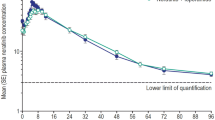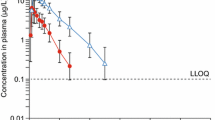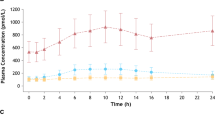Abstract
Purpose: Dolasetron is a selective 5-HT3 receptor antagonist. The purpose of this study was to determine the effect of cimetidine and rifampin on the steady-state pharmacokinetics of orally administered dolasetron and its active reduced metabolite, hydrodolasetron. Methods: A group of 18 healthy men (22 to 44 years old) were randomized to receive each of the following three treatments in a three-period crossover design: 200 mg dolasetron daily (treatment A); 200 mg dolasetron daily plus 300 mg cimetidine four times daily (treatment B); or 200 mg dolasetron daily plus 600 mg rifampin daily (treatment C). Each study period was separated by a 14-day washout period. Serial blood samples were collected before the first dose (baseline) on day 1 and at frequent intervals up to 48 h after the morning dose on day 7 for quantification of dolasetron and its metabolites, hydrodolasetron (both isomers), 5′OH hydrodolasetron, and 6′OH hydrodolasetron. Serial urine samples were also collected at baseline and during the periods 0–24 and 24–48 h following the morning dose on day 7, and analyzed for dolasetron and its metabolites. Results: Plasma and urine dolasetron concentrations were below quantifiable concentrations for all three treatments. Mean steady-state area under the plasma concentration-time curve (AUCss(0–24)) of hydrodolasetron increased by 24%, mean apparent clearance (CLapp,po) decreased by 19%, and maximum plasma hydrodolasetron concentration (Cmax,ss) increased by 15% when dolasetron was coadministered with cimetidine. When dolasetron was given with rifampin, mean hydrodolasetron AUCss(0–24) decreased by 28%, CLapp,po increased by 39%, and hydrodolasetron Cmax,ss decreased by 17%. Small differences were found in mean tmax (0.7 to 0.8 h), CLr (2.0 to 2.6 ml/min per kg), and t1/2 (7.4 to 8.8 h) for hydrodolasetron between treatment periods. Approximately 20% and 2% of the dolasetron dose were excreted in urine as the R(+) isomer and S(−) isomer of hydrodolasetron, respectively, across all three treatments. Dolasetron mesylate was well tolerated in this study during all three treatment periods, with the highest incidence of adverse events reported during the control period when dolasetron mesylate was given alone. Conclusion: Based on the small changes in the pharmacokinetic parameters of dolasetron and its active metabolites, as well as the favorable safety results, no dosage adjustments for dolasetron mesylate are recommended with concomitant administration of cimetidine or rifampin.
Similar content being viewed by others
Author information
Authors and Affiliations
Additional information
Received: 10 February 1998 / Accepted: 1 June 1998
Rights and permissions
About this article
Cite this article
Dimmitt, D., Cramer, M., Keung, A. et al. Pharmacokinetics of dolasetron with coadministration of cimetidine or rifampin in healthy subjects. Cancer Chemother Pharmacol 43, 126–132 (1999). https://doi.org/10.1007/s002800050872
Issue Date:
DOI: https://doi.org/10.1007/s002800050872




